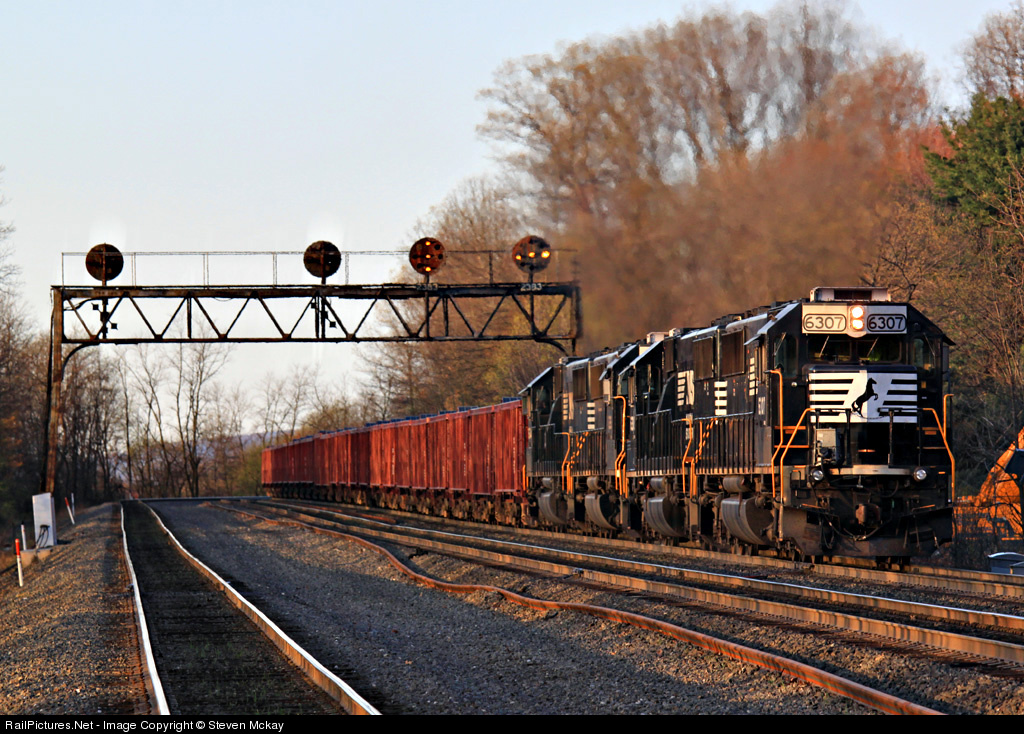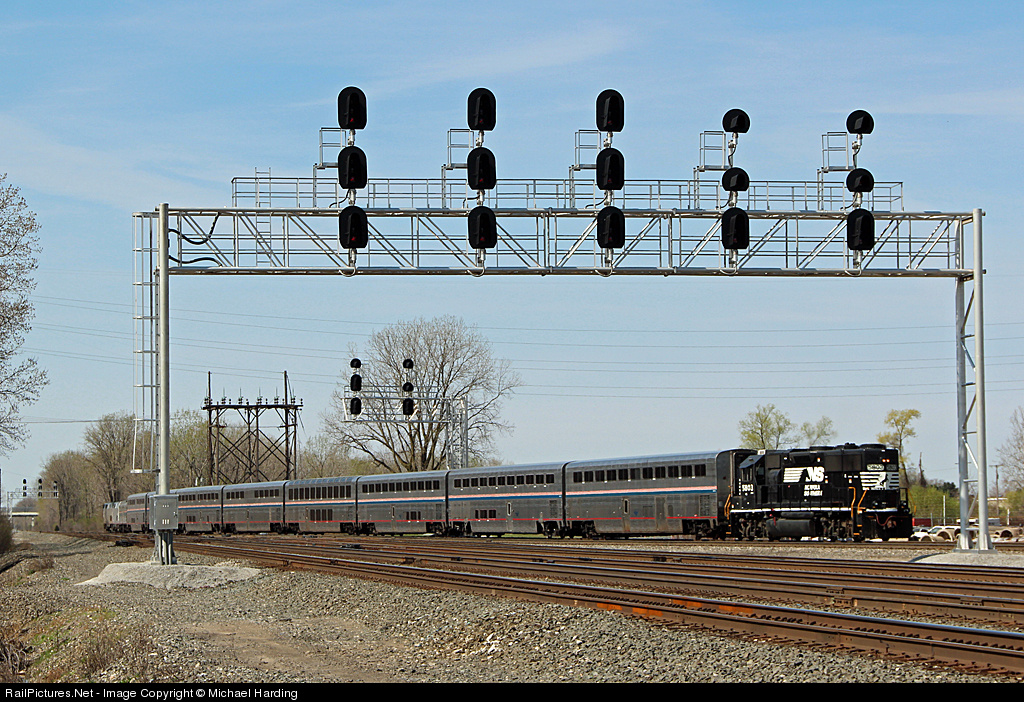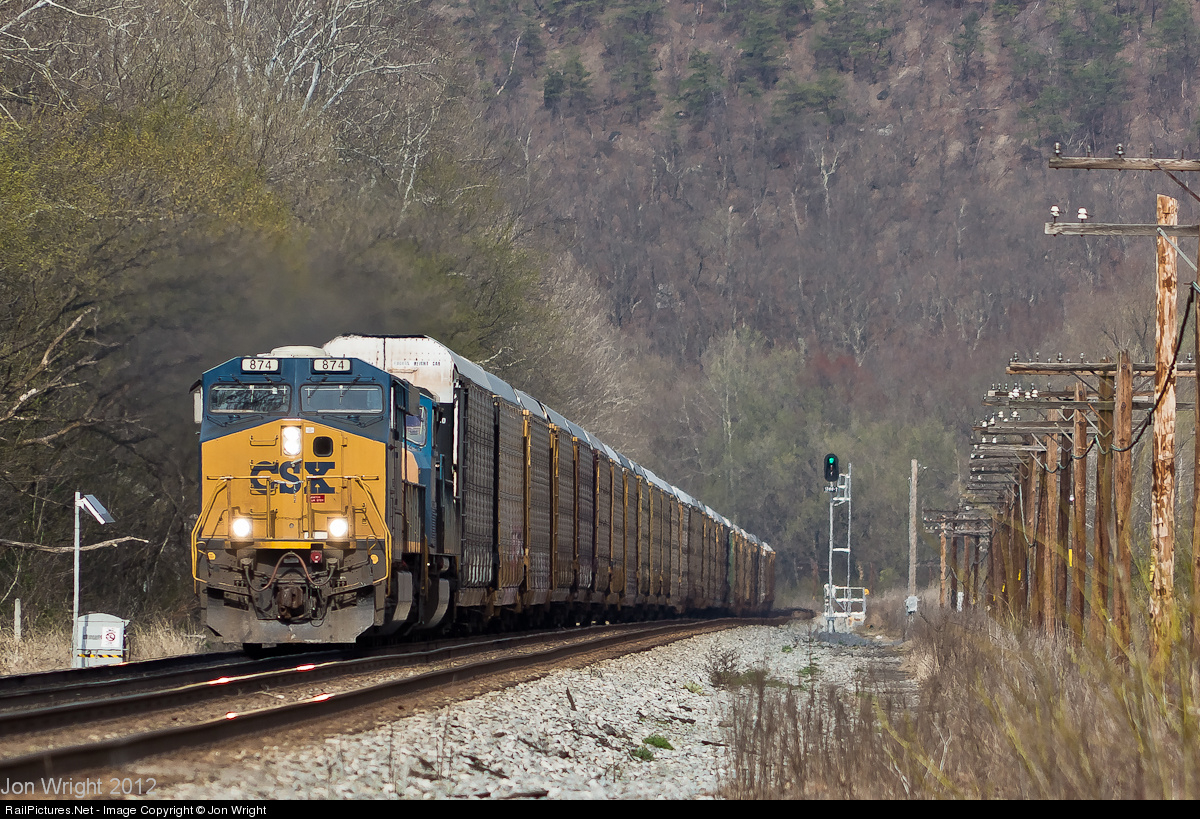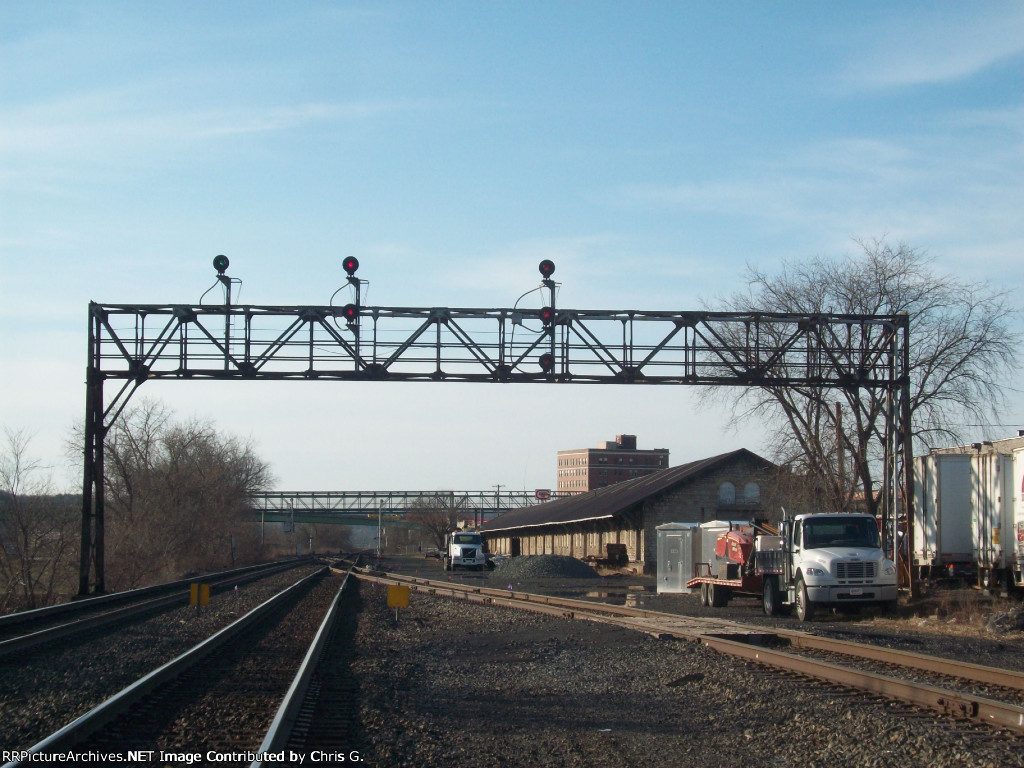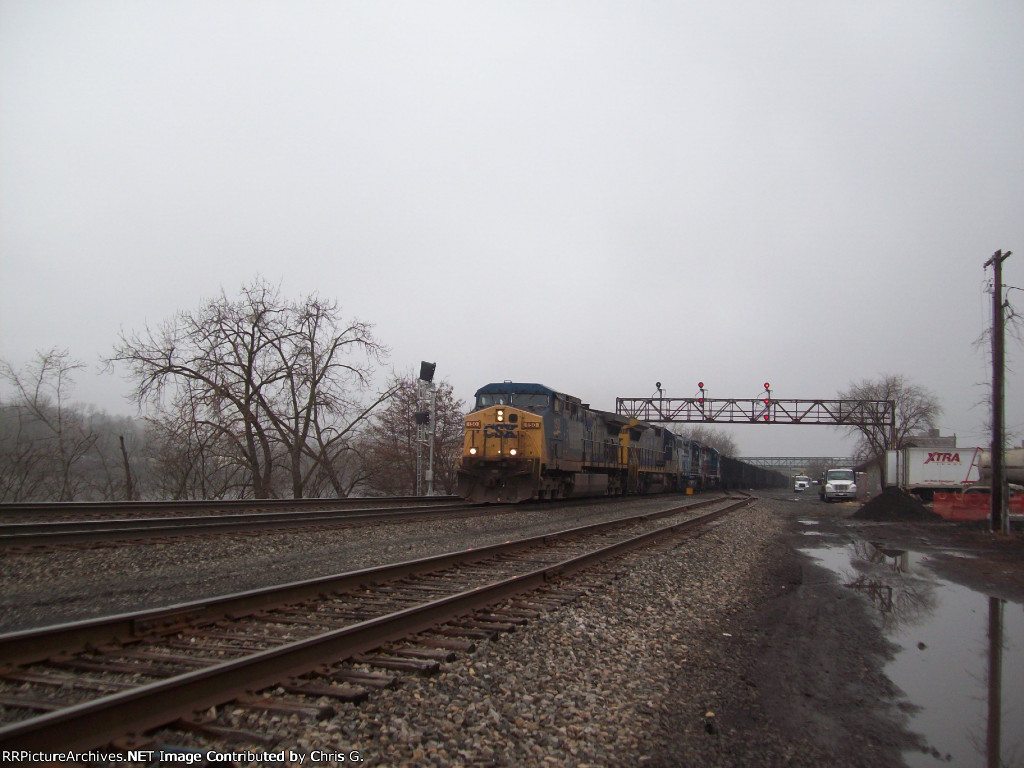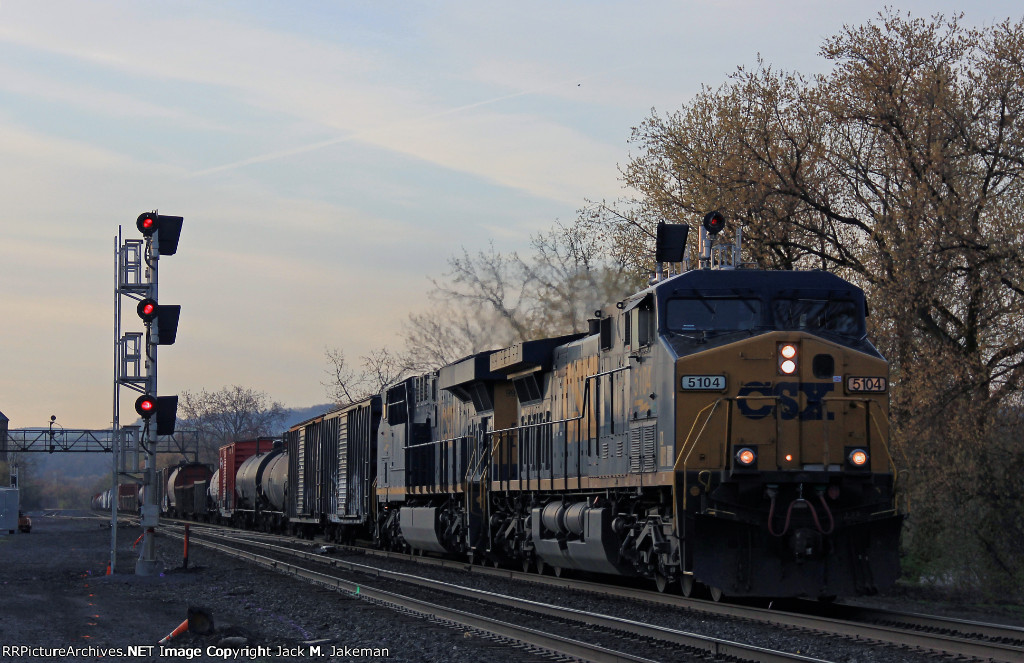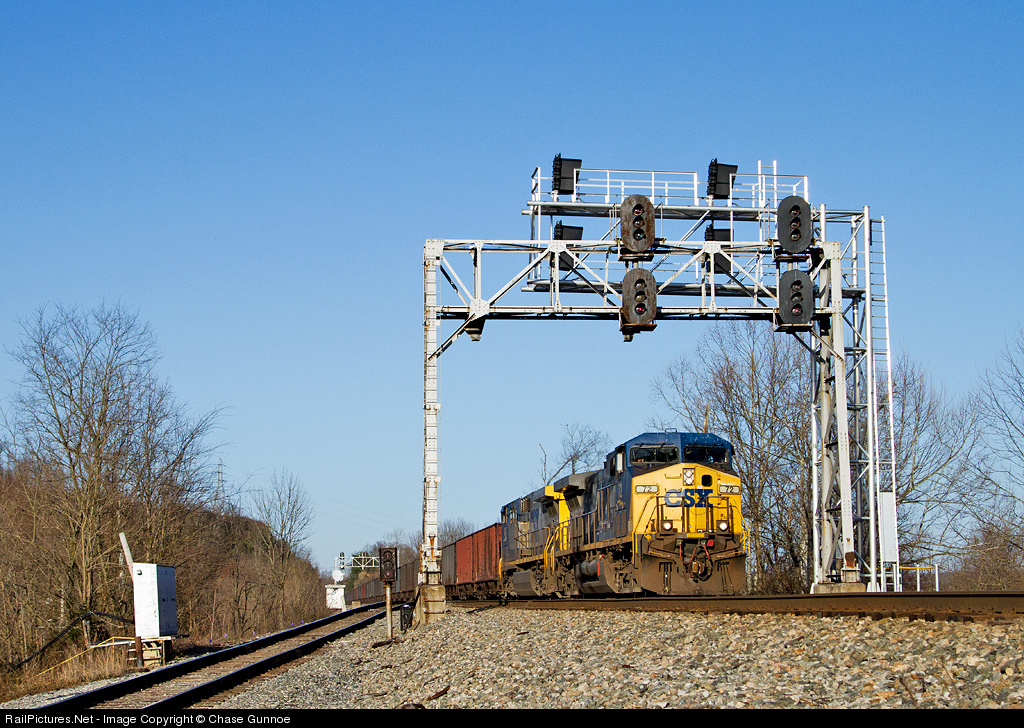Well ALTO tower may have a month or two left, but its eastbound distant signal, the PRR PL gantry at MP 238.4 has been replaced by the 3-track cantilever mast that's been stalking it since last August. I'm not sure how they are handling this as the old distant supported slow speed indications at SLOPE (most likely Slow Approach for the short block between there and ALTO), but the new cantilever only provides two headed Darth Vader hoods on their lower heads. I suspect they were changed to straight Approach to the Slow Approach indication at SLOPE.
Anyway here's a pic of the last train passing under the signal.
And the new signal...completely generic and sterile. If NS can spent the money on heritage paint schemes, why not heritage signaling at important railfan locations.
Fortunately I got out to take some high-res pics of the old signal. Bad
news it was in the rain and I was planning to get back there in a week
or two. Oh well, reduces the number of sites I need to hit.
A blog devoted to explaining the ins and outs of North American railroad signaling, past, present and future. This blog seeks to preserve through photo documentation the great diversity and technical ingenuity of 20th century signaling and interlocking hardware and technology. Related topics cover interlocking towers and railroad communications infrastructure.
Note, due to a web hosting failure some of the photos and links may be unavailable.
Search This Blog
Friday, March 30, 2012
Tuesday, March 27, 2012
Welcome to the New NASBY
Just wanted provide some closure to my previous story on the fall of the clasic New York Central 5-track signal bridge at the former NASBY interlocking, which had its manned interlocking tower survive well into the 1990's. Well the new signal gantry is in service and as you can see all that money has made the interlocking less capable than it was before. Under the old configuration the two yard tracks used to have medium speed routes through the plant, but under the new configuration those have been reduced to slow speed routes. Yay progress!!
Sunday, March 25, 2012
Time Expires for CSX Cumberland Sub CPLs
Well it's official, the second half of the CSX CPL/pole-line elimination project on the Cumberland Sub has been completed with the remaining signaling locations between HANCOCK and ORLEANS ROAD going under the knife. This included the interlocking at GRASSHOPPER HOLLOW and the iconic CPL gantries at AMBROSE. In fact as this section of the line was originally 3 tracks most of the intermediate signals consisted of 2-track bi-directional B&O CPL signal bridges. Probably the best surviving concentration of B&O signal bridges that remained anywhere. Fortunately I was able to thoroughly document these endangered signals last December with over 500 high resolution photos so stay tuned for some upcoming series on the B&O Main Line CPLs.
Here we see the new pair of Darth Vader masts that replaced both re-existing intermediates at Ambrose and Sir John. The pole line has already been stripped of wire and will probably get cut down in coming years.
Here we see the new pair of Darth Vader masts that replaced both re-existing intermediates at Ambrose and Sir John. The pole line has already been stripped of wire and will probably get cut down in coming years.
Thursday, March 22, 2012
PHOTOS: PAOLI Interlocking
Today in our continuing study of active, former Pennsylvania Railroad interlocking towers on Amtrak's Harrisburg Line we look at PAOLI interlocking and tower in Paoli, Pennsylvania. While less interesting technologically than the adjacent THORN Tower, PAOLI has a lot more history and, until recently, much more importance. PAOLI Tower was built in 1896 with a mechanical frame and shared design elements with adjacent BRYN MAWR tower and CLY tower a bit further away on the banks of the Susquehanna River. PAOLI was an intermediate design between the generation of all wood towers and the later PRR standard all-brick towers. It literally split the difference with a brick base and a wooden upper story. I will cover more about the particulars of the tower in the second part, first I will document the interlocking equipment in the field.
The story of PAOLI interlocking is a story of the Philadelphia Main Line. While today the Main Line is synonymous with wealth and privileged, it started out as just a line of typical agrarian communities that the Pennsylvania Railroad had chosen to build its Main Line through in the first half of the 19th Century. In the second half of said century growing urbanization made the downtown area less desirable as a place to live and as a response the railroad began to encourage development along its main line to help grow the then nascent commuter business. The upper tiers of railroad management were encouraged to live in Main Line communities and the railroad directly financed some development and local infrastructure. By the 1890's the Main Line was growing nicely and the PRR responded with infrastructure upgrades that included ornate station buildings with manicured grounds, closely spaced automatic block signaling to enable a high throughput of trains and finally two new interlockings on the 4-track line, one at BRYN MAWR and the other at PAOLI.
While BRYN MAWR was constructed as a 4-track crossover and intermediate local train turnback, PAOLI was designed as the terminal point for the commuter service along the line. Just about 20 miles from Broad Street Station in Philadelphia PAOLI fist managed the swarm of steam hauled commuter trains and their various combinations of local, limited and express service. Later, in 1915, the busy line was chosen to be host to an experimental 11kv, 25Hz overhead electrification scheme that would rid the upper class area of much of the soot and smoke generated by the steam commuter trains. Paoli would remain as the terminus for the service and would also host the storage yard and shop facility for the new fleet of MP-54 MU cars.
PAOLI tower was built as a mechanical interlocking, even tho power frame technology was available and even installed in nearby BRYN MAWR tower. Originally a 4-track crossover with various connections to the MU yard (including a duck-under to allow MUs to avoid trying up the main with crossing moves), in 1923 the East End was added on a separate electric machine. The East End allowed trains on the center express tracks to access the side platforms without having to platform across tracks 1 or 4. Later the interlocking was completely rebuilt in 1929 with a then state of the art US&S Model 14 Electro-Pneumatic machine replacing both mechanical and supplementary electric frame (probably a table interlocker).
Here is how PAOLI interlocking looked in the late 1960s after the 4th track had been removed west of the interlocking.
PAOLI Interlocking diagram
By this time track #3 east of the interlocking has been made bi-directional possibly either freight trains (which were still an important component of the line's traffic) to run during the busy morning rush, or just due to the fact that the morning rush is more concentrated than the evening rush. Track #2 west of the interlocking was also bi-directional to make up for the loss of the 4th track. This track would eventually be removed entirely as all through freight service dried up and left the then Amtrak owned main line in the early 1980's. The 15/17 and 17/19 switches has been built as double-slips, but by this time has been converted to regular operation. Note the duckunder track for eastbound MU trains entering the main as well as two yard access tracks for westbound trains that allowed a local and express train to exit the main simultaneously. On the East End the 29 and 25 switches allow for express-local crossovers, while I still have yet to discover the operational use for the 27 switch as it is not placedin what would be a more logical setup that allows a platforming train access to the reverse signaled #3 track.

Moving ahead to 1992 we see that #4 track west of the interlocking has been re-connected to allow trains to move straight through on that track without needing a diverging move. #3 track no vanishes at the #11 switch which has been changed from a crossover to a turnout. The Fillout track which allowed storage of an MU set between tracks 2 and 3 has been converted into a stub and disconnected from track #4, although the 2R signal remains to protect the phantom switch. Track #2 has been cut west of the interlocking.
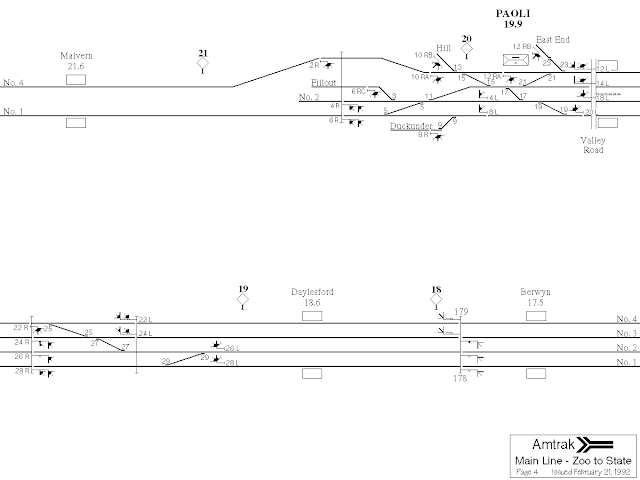
In 1995 more changes came to the Paoli area, although not to the interlocking itself. Since 1915 the MU yard and shop complex had become a major source of PCB contamination due to ignorance about the hazards of the substance. The yard sat on the divide between two watersheds and as such managed to contaminate large stretches of waterway in the batter part of 3 counties. With the Paoli shop not only outmoded technologically, but also constituting a major environmental disaster SEPTA, the commuter rail operator, built a new storage yard at FRAZER, about 4 miles west of Paoli and a new shop complex on a former freight rail yard in the Overbrook section of Philadelphia. The terminal for the R5 service was then moved to Malvern with trains entering and exiting the main line at FRAZER interlocking, which was remote to THORN tower. PAOLI still had the task of routing trains via the local or express tracks and crossing them over from the same. PAOLI would have probably gotten the FRAZER panel if not for a 1994 fire in BRYN MAWR tower that required the interlocking to be re-built. As BRYN MAWR was only open part time in the peak hours to turn the local trains that terminated there the obvious decision was to use the insurance funded capitol project to remote control to PAOLI. The workload for the PAOLI operator was then such that the FRAZER panel went to THORN.
Alright, time for some photos. The tour will run from east to west and as such here is the easternmost point of PAOLI interlocking, the 26L and 28L position light dwarf signals for wrong direction movements on 1 and 2 track.
These signals and the 29 switch they protect are well to the east the signals for 3 and 4 track for some reason. The 29 switch is used by express train to cross over to the inner express tracks.
The story of PAOLI interlocking is a story of the Philadelphia Main Line. While today the Main Line is synonymous with wealth and privileged, it started out as just a line of typical agrarian communities that the Pennsylvania Railroad had chosen to build its Main Line through in the first half of the 19th Century. In the second half of said century growing urbanization made the downtown area less desirable as a place to live and as a response the railroad began to encourage development along its main line to help grow the then nascent commuter business. The upper tiers of railroad management were encouraged to live in Main Line communities and the railroad directly financed some development and local infrastructure. By the 1890's the Main Line was growing nicely and the PRR responded with infrastructure upgrades that included ornate station buildings with manicured grounds, closely spaced automatic block signaling to enable a high throughput of trains and finally two new interlockings on the 4-track line, one at BRYN MAWR and the other at PAOLI.
While BRYN MAWR was constructed as a 4-track crossover and intermediate local train turnback, PAOLI was designed as the terminal point for the commuter service along the line. Just about 20 miles from Broad Street Station in Philadelphia PAOLI fist managed the swarm of steam hauled commuter trains and their various combinations of local, limited and express service. Later, in 1915, the busy line was chosen to be host to an experimental 11kv, 25Hz overhead electrification scheme that would rid the upper class area of much of the soot and smoke generated by the steam commuter trains. Paoli would remain as the terminus for the service and would also host the storage yard and shop facility for the new fleet of MP-54 MU cars.
PAOLI tower was built as a mechanical interlocking, even tho power frame technology was available and even installed in nearby BRYN MAWR tower. Originally a 4-track crossover with various connections to the MU yard (including a duck-under to allow MUs to avoid trying up the main with crossing moves), in 1923 the East End was added on a separate electric machine. The East End allowed trains on the center express tracks to access the side platforms without having to platform across tracks 1 or 4. Later the interlocking was completely rebuilt in 1929 with a then state of the art US&S Model 14 Electro-Pneumatic machine replacing both mechanical and supplementary electric frame (probably a table interlocker).
Here is how PAOLI interlocking looked in the late 1960s after the 4th track had been removed west of the interlocking.
PAOLI Interlocking diagram
By this time track #3 east of the interlocking has been made bi-directional possibly either freight trains (which were still an important component of the line's traffic) to run during the busy morning rush, or just due to the fact that the morning rush is more concentrated than the evening rush. Track #2 west of the interlocking was also bi-directional to make up for the loss of the 4th track. This track would eventually be removed entirely as all through freight service dried up and left the then Amtrak owned main line in the early 1980's. The 15/17 and 17/19 switches has been built as double-slips, but by this time has been converted to regular operation. Note the duckunder track for eastbound MU trains entering the main as well as two yard access tracks for westbound trains that allowed a local and express train to exit the main simultaneously. On the East End the 29 and 25 switches allow for express-local crossovers, while I still have yet to discover the operational use for the 27 switch as it is not placedin what would be a more logical setup that allows a platforming train access to the reverse signaled #3 track.

Moving ahead to 1992 we see that #4 track west of the interlocking has been re-connected to allow trains to move straight through on that track without needing a diverging move. #3 track no vanishes at the #11 switch which has been changed from a crossover to a turnout. The Fillout track which allowed storage of an MU set between tracks 2 and 3 has been converted into a stub and disconnected from track #4, although the 2R signal remains to protect the phantom switch. Track #2 has been cut west of the interlocking.

In 1995 more changes came to the Paoli area, although not to the interlocking itself. Since 1915 the MU yard and shop complex had become a major source of PCB contamination due to ignorance about the hazards of the substance. The yard sat on the divide between two watersheds and as such managed to contaminate large stretches of waterway in the batter part of 3 counties. With the Paoli shop not only outmoded technologically, but also constituting a major environmental disaster SEPTA, the commuter rail operator, built a new storage yard at FRAZER, about 4 miles west of Paoli and a new shop complex on a former freight rail yard in the Overbrook section of Philadelphia. The terminal for the R5 service was then moved to Malvern with trains entering and exiting the main line at FRAZER interlocking, which was remote to THORN tower. PAOLI still had the task of routing trains via the local or express tracks and crossing them over from the same. PAOLI would have probably gotten the FRAZER panel if not for a 1994 fire in BRYN MAWR tower that required the interlocking to be re-built. As BRYN MAWR was only open part time in the peak hours to turn the local trains that terminated there the obvious decision was to use the insurance funded capitol project to remote control to PAOLI. The workload for the PAOLI operator was then such that the FRAZER panel went to THORN.
Alright, time for some photos. The tour will run from east to west and as such here is the easternmost point of PAOLI interlocking, the 26L and 28L position light dwarf signals for wrong direction movements on 1 and 2 track.
These signals and the 29 switch they protect are well to the east the signals for 3 and 4 track for some reason. The 29 switch is used by express train to cross over to the inner express tracks.
Tuesday, March 20, 2012
I Can't believe It... Chicago Line CP-175
The greatest tragedy is when recently installed classic signals are replaced...putting a premature end to what could have been a valuable item of living history for decades to come. The Chicago Line is no stranger to this odd bit of decision making with NS replacing the 1980's vintage tubular cantilevers with the small target Michigan Central style searchlights. It this time it's CSX's turn in a more heartbreaking decision to replace the same type of small target searchlights at CP-175 in Amsterdam, NY which was re-signaled by CSX itself only a few short years ago. Back when CSX actually cared about saving money they installed brand new three-head small target semaphore masts for eastbound movements and re-wired the signals on the 3-track westbound New York Central signal gantry. Well the construction crews are out with new relay huts and Darth Vader masts going up. I suspect they are spending stimulus funds earmarked for the Empire High Speed Rail corridor. Anyway, if you live in the area get your pictures while you can, especially of those brand new eastbound masts.
And of course the real shame....the brand new small target searchlight masts being replaced by Darth Vader heads. Is it really cheaper to just splice the new interlocking wires into the existing equipment??
And of course the real shame....the brand new small target searchlight masts being replaced by Darth Vader heads. Is it really cheaper to just splice the new interlocking wires into the existing equipment??
Saturday, March 10, 2012
CSX's Darth Vader's Near and Far
Just noticed two portends of oncoming evil yesterday, Looks like Darth Vader signals are going up both on the Northern Sub near the junction with recently converted Cincinnati Sub and then again in Jessup Georgia on the S-Line to Flordia. If you happened to live near those areas get your cameras out and take as make photos as you can.
Sciotoville, Ohio:
Jessup, GA:
Sciotoville, Ohio:
Jessup, GA:
Tuesday, March 6, 2012
PRR Main Line Survey 2010 Part 12 (CORK to PAOLI)
We continue on our Eastbound trip over the former Pennsylvania Railroad Main Line between Philadelphia and Harrisburg and how its 1930's era signaling is gradually being upgraded to modern standards. In this section we will travel between HOLLAND interlocking near Lancaster, PA and PAOLI interlocking in Paoli, PA. The section between Harrisburg and Lancaster has been completely re-signaled, while the Main Line section has been left almost entirely intact. This middle section is actually in transition between old and new and I will show that in the pictures.
You can follow along on Blockstation.net starting at page C-12 and of course on my master list of photos.
I will begin back with the photo I left off with taken at HOLLAND interlocking, which used to be the Conestoga section of CORK interlocking on the old Model 14 machine. The Conestoga section was where, until 1948, the 4-track line reduced to 2 tracks to travel over the stone arch bridge over the Conestoga Creek. In 1948 the PRR halved the number of tracks on the "passenger" main line as freight trains were shifted onto the Atglen and Susquehanna low grade line. A single trailing crossover remained until CORK was re-signaled at which point it was removed. Anyway, at the time this was taken this section of line was still running under Rule 251, single direction ABS, with single direction Cab Signals. A temporary auto mast was erected at Holland after the 6L CORK signal was removed. The signal maintainers are out on this weekend day trying to get the next section of Rule 562 operation cut in between here and what will soon be LEAMAN interlocking.
About 1500 feet east and around the bend we find another maintainer working at the cab signal cut point for HOLLAND interlocking on #4 track, previously for CORK on both tracks. As HOLLAND is only in service on #4 track I am unsure what purpose maintaining the cut point would serve on #1 track unless it has been removed w/ the old insulated joint bridged over in the relay box. I guess it could serve as an extra block for the waysideless CSS.
As was common practice under Rule 251, industrial sidings were built to join the main line with safer trailing point switches. In fact there was only a single facing point siding track along the entire 107 mile Harrisburg Line. Protection was provided via a simple time lock which would shunt the cab signal coded track circuit and then run a short 5 minute timer before the hand throw point/derail combination was allowed to be thrown. Rule 562 operation will mean bi-directional running and increased attention to any issues with these potentially facing turnouts, although they always had to be ready for wrong direction movements even under Rule 251. Note the turnout was replaced when the line was upgraded for 110mph operation with concrete times and a spring frog.
The new defect detectors are of the Radio type (replacing the Servograph units in CORK tower) and, unlike previous Amtrak detectors, readout the milepost only, not the detector name (which in this case is Conestoga). Two detector's on Amtrak's Springfield Line still read out locations (Windsor and Berlin) as does one on the NEC near Boston (Hawk).
The 645 wayside distant to HOLLAND interlocking on track #4 is still bagged and waiting to go into service while a maintainer works in the relay hut.
The 635 automatic is the first classic PRR amber type automatic signal east of HOLLAND and is serving out its last few months in service. The use of the wide overhead gantry is a function of the 4-track RoW. It appears that this will remain an active block boundary / CSS code change point as evidenced by the new relay hut and maintainer.
The 615 automatic is next. Note these all have the Stop and Proceed marker lamps as well as the number plate.
The gates at the Irishtown grade crossing are beginning to rise as two rail enthusiasts scramble out to get their tripod repositioned. This is one of three remaining grade crossings on the line and the one seeing the fastest trains (90-100mph). The crossing is protected by AHBs and due to the significant Amish population in the area one is very likely to catch a horse drawn buggy waiting for a passing high speed electric train. The crossing is scheduled to be replaced with some sort of overpass due to $26 million of stimulus money. Unfortunately I see this as little better as a wasteful mark work project that will do little to increase safety at these low use crossings and will not only destroy a popular railfan location, but also impact horses that will have to work up and down steep overpass ramps.
For those of you who are fans of the British motoring show Top Gear, this crossing is located about 1.7 miles from the town of Intercourse, Pennsylvania which the presenters stopped at for the sole reason of a sight gag at the town's welcome flag. Really? You went miles out of you way for a stupid sex joke? That was the best idea you could come up with on your US East Coast road trip?
You can follow along on Blockstation.net starting at page C-12 and of course on my master list of photos.
I will begin back with the photo I left off with taken at HOLLAND interlocking, which used to be the Conestoga section of CORK interlocking on the old Model 14 machine. The Conestoga section was where, until 1948, the 4-track line reduced to 2 tracks to travel over the stone arch bridge over the Conestoga Creek. In 1948 the PRR halved the number of tracks on the "passenger" main line as freight trains were shifted onto the Atglen and Susquehanna low grade line. A single trailing crossover remained until CORK was re-signaled at which point it was removed. Anyway, at the time this was taken this section of line was still running under Rule 251, single direction ABS, with single direction Cab Signals. A temporary auto mast was erected at Holland after the 6L CORK signal was removed. The signal maintainers are out on this weekend day trying to get the next section of Rule 562 operation cut in between here and what will soon be LEAMAN interlocking.
About 1500 feet east and around the bend we find another maintainer working at the cab signal cut point for HOLLAND interlocking on #4 track, previously for CORK on both tracks. As HOLLAND is only in service on #4 track I am unsure what purpose maintaining the cut point would serve on #1 track unless it has been removed w/ the old insulated joint bridged over in the relay box. I guess it could serve as an extra block for the waysideless CSS.
As was common practice under Rule 251, industrial sidings were built to join the main line with safer trailing point switches. In fact there was only a single facing point siding track along the entire 107 mile Harrisburg Line. Protection was provided via a simple time lock which would shunt the cab signal coded track circuit and then run a short 5 minute timer before the hand throw point/derail combination was allowed to be thrown. Rule 562 operation will mean bi-directional running and increased attention to any issues with these potentially facing turnouts, although they always had to be ready for wrong direction movements even under Rule 251. Note the turnout was replaced when the line was upgraded for 110mph operation with concrete times and a spring frog.
The new defect detectors are of the Radio type (replacing the Servograph units in CORK tower) and, unlike previous Amtrak detectors, readout the milepost only, not the detector name (which in this case is Conestoga). Two detector's on Amtrak's Springfield Line still read out locations (Windsor and Berlin) as does one on the NEC near Boston (Hawk).
The 645 wayside distant to HOLLAND interlocking on track #4 is still bagged and waiting to go into service while a maintainer works in the relay hut.
The 635 automatic is the first classic PRR amber type automatic signal east of HOLLAND and is serving out its last few months in service. The use of the wide overhead gantry is a function of the 4-track RoW. It appears that this will remain an active block boundary / CSS code change point as evidenced by the new relay hut and maintainer.
The 615 automatic is next. Note these all have the Stop and Proceed marker lamps as well as the number plate.
The gates at the Irishtown grade crossing are beginning to rise as two rail enthusiasts scramble out to get their tripod repositioned. This is one of three remaining grade crossings on the line and the one seeing the fastest trains (90-100mph). The crossing is protected by AHBs and due to the significant Amish population in the area one is very likely to catch a horse drawn buggy waiting for a passing high speed electric train. The crossing is scheduled to be replaced with some sort of overpass due to $26 million of stimulus money. Unfortunately I see this as little better as a wasteful mark work project that will do little to increase safety at these low use crossings and will not only destroy a popular railfan location, but also impact horses that will have to work up and down steep overpass ramps.
For those of you who are fans of the British motoring show Top Gear, this crossing is located about 1.7 miles from the town of Intercourse, Pennsylvania which the presenters stopped at for the sole reason of a sight gag at the town's welcome flag. Really? You went miles out of you way for a stupid sex joke? That was the best idea you could come up with on your US East Coast road trip?
Subscribe to:
Posts (Atom)
